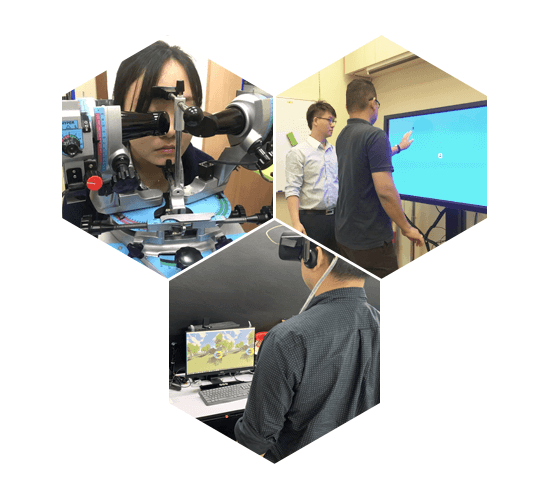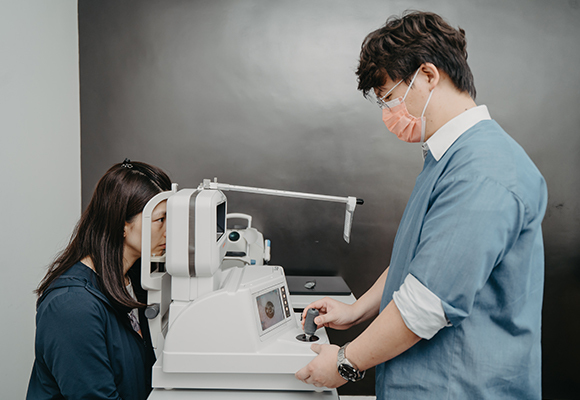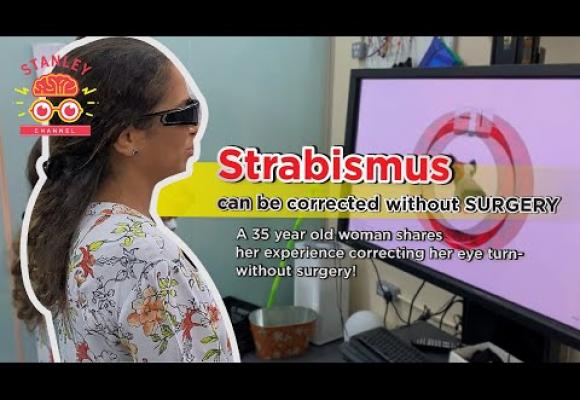Eye Turn (Strabismus, Mata Juling斗鸡眼/斜视)
Strabismus is often called crossed eyes because the eyes can look like they are crossed, but it is an eye turn. Strabismus (Eye Turn, Mata Juling 斗鸡眼/斜视) is a condition where the two eyes are not looking at the same point at the same time.
Based on the direction the eye turns, strabismus can be classified as an inward eye turning (esotropia), outward turning (exotropia), upwards turning (hypertropia), and downward turning (hypotropia).
Sometimes you can see the eye turn (Strabismus, Mata Juling 斗鸡眼/斜视) and other times you can’t because it only turns when the child looks at objects up close or if he is tired or not feeling well.
What is the difference between Lazy Eye and Eye Turn?
Lazy eye is a problem with visual acuity in one or both eyes that cannot be improved with glasses or contact lenses alone. The brain suppresses the information from either one or both eyes and doesn’t send the visual signal to the affected eye, make it eventually become weak. Eye turn also called “Strabismus” is a problem in which both eyes do not focus on the same point at the same time. The patients do not necessarily require vision correction because they may have 20/20 normal visual acuity. They just suffer due to misaligned eye problems.
Why might you have Eye Turn?
- Eye Turn by Birth
Eye turn can happen during early childhood due to the genetic of the family. It is normal for a newborn's eyes to cross sometimes during the first few months. By that time, the eyes usually straighten out. Generally, develops up to age 6 years. On the other hand, a child might be more likely to have an eye turn if they have developmental disabilities. This condition happens because the vision in the eyes might not develop the way it should.
- Eye Turn by Accident
Eye turn can result from strokes, car accidents, concussions, etc. Research showed that 90% of traumatic brain injury (TBI) patients experience some visual problems due to the disruption of communication between the eyes and the brain. Injury to any part of visual pathways can affect the field of vision, the position of the eye, and how the eye moves.
Common Signs and Symptoms of Eye Turns (Strabismus, Mata Juling)
- One eye seems to turn inward (esotropia) or outwards (exotropia), either constantly or occasionally
- Both eyes turn inwards (esotropia) or outwards (exotropia)
- Eyes don’t seem to move correctly; either constantly or occasionally
- Squints or closes one eye
- Covers one eye while reading or looking at something close up
- Inability to respond to some visual stimuli
- Difficulty following moving objects
- Bumps into objects while walking
- The trouble with depth perception
- Poor eye-hand coordination (poor handwriting, for example)
- Uses finger to keep place when reading
- Skips words when reading out loud
- Moves head when reading
- Complains of blurry vision or double images (diplopia)
- Has trouble seeing 3D
How would Eye Turn affect an adult
A lot of eye turns (Strabismus, Mata Juling 斗鸡眼/斜视) are easy to see and those people with strabismus often become self-conscious. When the eye turn occurs occasionally or on and off throughout the day, it is not as obvious for people to see.
Most adults have had surgery when they were younger to treat the eye turn (Strabismus, Mata Juling 斗鸡眼/斜视). While their eyes may look straight, they often do not have full use of both of their eyes. And, they don’t work together to provide full 3D vision the way they should.
Reading, driving, sports performance, and even one’s ability to work can be affected by an eye turn (Strabismus, 斗鸡眼/斜视). In today’s world being able to see 3D has become very important. Individuals with eye turns cannot see the 3D effects in movies, etc.
Is it possible to fix the Eye turn for an adult?
Golden/Critical Period
While you may have been told that there is a golden/critical period where you can treat Strabismus/Amblyopia, and that after this period it is no longer possible for eye turning treatment - research has found that it is possible to help both conditions no matter how old you are, even if you are an adult.
Through Behavioral & developmental optometry we are able to help our patients learn how to use their eyes correctly at any age. In order to see if we can help you or your loved ones in treating eye turns (Strabismus, Mata Juling, 斜视), schedule a Neuro-functional vision evaluation with our Behavioral and Developmental optometrist.
Questions
Is It Too Late?
Many people think that vision therapy is only for children. However, adults have as much need for this type of vision care as children. Vision Therapy is often more effective for adults because they are usually more motivated to improve their visual abilities, whereas children may not understand that they have a problem or how that problem may affect their interests or future.
Plenty of people have visual problems sustaining near-centered work, including reading, writing, and computer use. When people have trouble using both eyes together or can't focus for great lengths of time, they do not simply grow out of these problems. Children with visual problems often become adults with visual problems.
Why Are Older Children, Teenagers and Adults with Lazy Eye Still Being Told That Nothing Can Be Done for Them? by neurobiologist Susan R. Barry, Ph.D. and Rachel Cooper
How Vision Problem Can Affect Your Life
Adults will figure out many ways to compensate for their visual problems so that they can continue with any strenuous visual work they need to do. Often, adults come home from work extremely tired when all they did was sit at a desk and do paperwork. Some people will feel as if they had just run a 10K race! Children, on the other hand, will tend to avoid tasks that are difficult or make them feel inadequate.
Mr Stanley with Dr Barry – Even Adults Can Be Helped with Neuro-Vision Therapy

Dr Susan R. Barry is a neuroscientist and a professor in the United States who has benefited from vision therapy as an adult. She shares her story in her book, Fixing My Gaze: A Scientist’s Journey into Seeing in Three Dimensions. In chapter 3, Dr. Barry even shares out her childhood experience after three strabismus surgeries:
“Even though my eyes appeared straight and aligned, I still didn’t use them normally. Both of my eyesights were 20/20 and had no problem passing a standard school vision screening. Yet, my vision was abnormal because I did not use my two eyes together. I was dreaded to go to grade school......when I looked down at the letters on the page, they didn’t stay in one place. My eye problem got worse as the print got smaller….”
Dr Barry did not have any developmental delays or challenges other than her vision. Imagine the amount of visual confusion that a special needs child experiences after eye surgery comparing to normal children. The good news is that we are able to help these children, normal or special needs, to treat their eye disorders without surgery (in most cases) and after surgery (for those who absolutely need it).
Available Eye Turn Treatment for Adult in Malaysia
Understanding the different eye turn treatment has different efficiency to you. However, the important part is how to fix the eye turn for you? There are 3 approaches to treat the eye turn in Malaysia.
- Surgery:
The operation usually weakens or strengthens the muscles of the eye, so that the eyes can be aligned. However, surgery treatment can be an over or under correction of the squint, so it is necessary for more than one operation to obtain the best results.
- Botulinum toxin injection:
This injection weakens the eye muscles so that the eyes can be aligned. However, the effects are transient and can be sustained only with repeated injections, its effects in some types of squint can be permanent.
At Sun Time Vision Specialists Centre, our specialized behavioral and developmental optometrist provide a very effective, non-surgical treatment that helps our patients eliminate eye turns (Strabismus, Mata Juling 斗鸡眼/斜视).
We are able to teach our patients to use their two eyes together correctly which gets rid of the eye turn. Just as there is physical therapy or speech therapy, there is Vision Therapy— therapy for the eyes. Our Behavioral and Developmental optometrist at Sun Time Vision Specialists Centre are certified to provide optometric Vision Therapy. We are able to teach children and adults how to use their two eyes correctly, and to treat a variety of vision problems which are not fully treatable with glasses, contact lenses or surgery.

Get a free consultation to correct your Eye Turn
A Neuro-Developmental & Behavioral optometrist can help to reduce the strain of near work as well as work with any other kinds of visual problems. The proper lenses along with vision therapy could make a tremendous difference in an adult's ability to function at work or sports, just as with children of school age.
We understand that you might have a number of questions; especially if this is the first time you are hearing that you may have a vision problem.
Please feel free to call our office with your questions. Phone 03- 2110 3967 or Whatsapp us. The first step to treat eye turn (Strabismus, Mata Juling 斜视) is to schedule a Neuro-Developmental & functional vision evaluation to determine to what degree the vision problem is contributing to your difficulties. Once the testing is completed our Behavioral and Developmental optometrist will meet with you in a separate appointment to review the results and go over the recommended program to treat strabismus.




